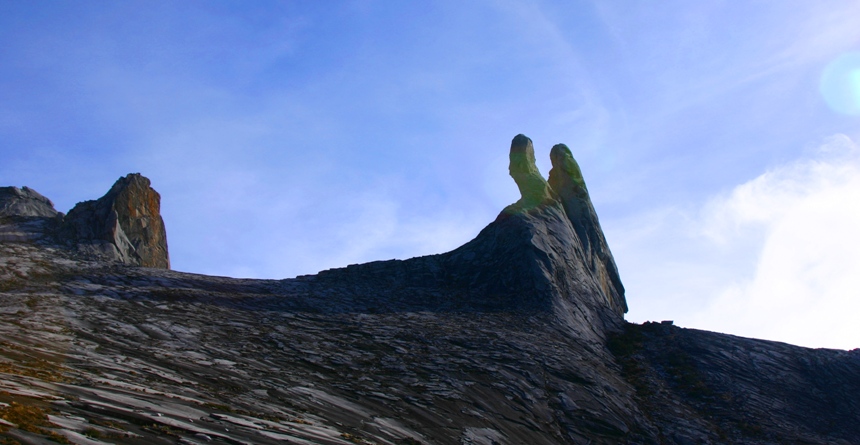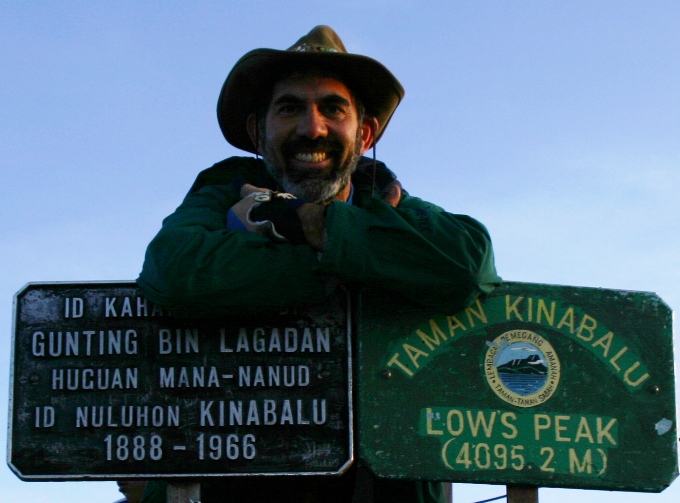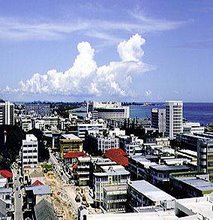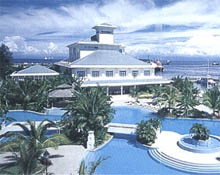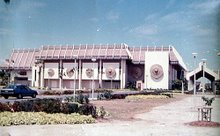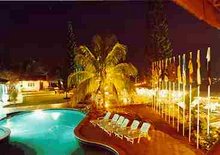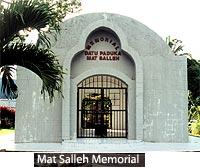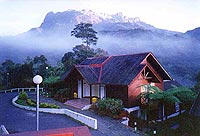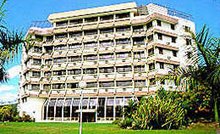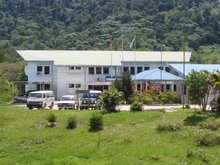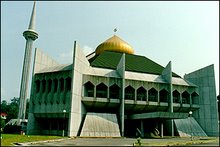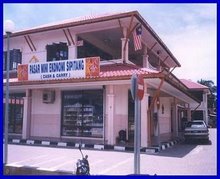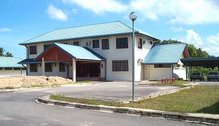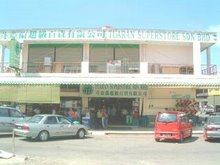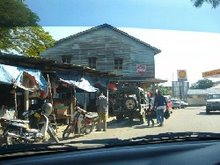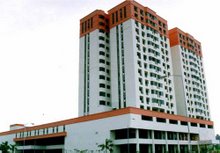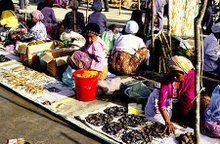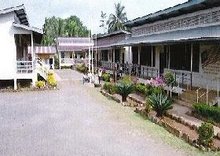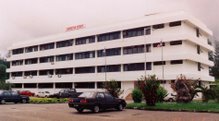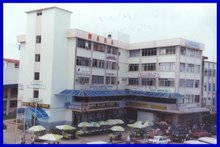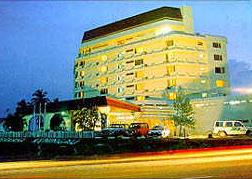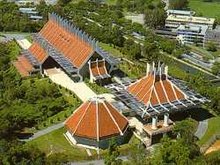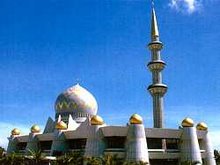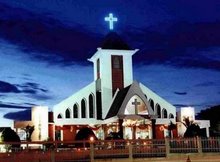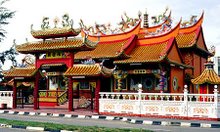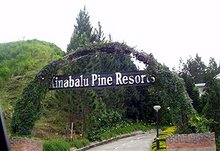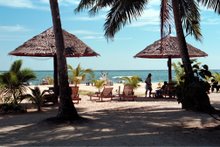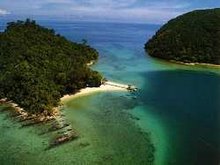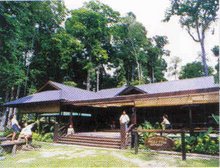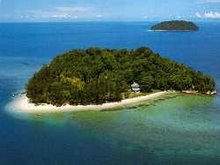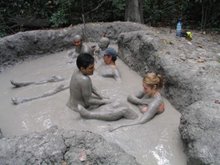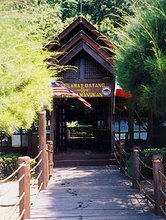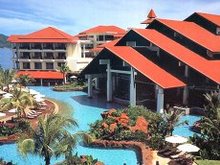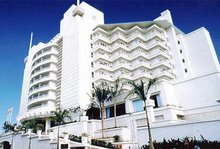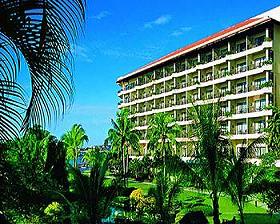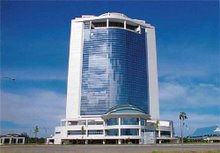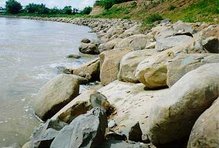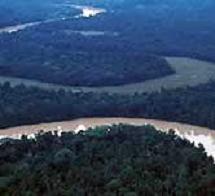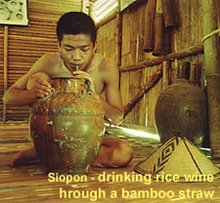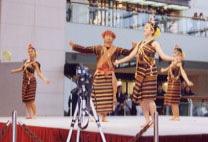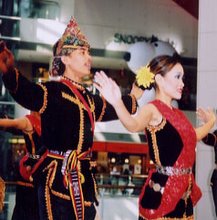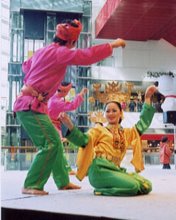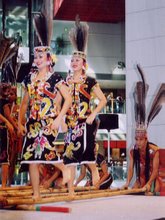welcome to sabah
(land below the wind)
(malaysia tourism)
Introducing Sabah, that make Sabah Malaysia Borneo one of the best place to live in or visit

GEOGRAPHY:
SABAH, the second largest state in Malaysia, is bordered by Sarawak on its southwestern side, and Kalimantan (Indonesian Borneo) to the south, occupying the top portion of the island of Borneo. She lies between 4° and 8° North of the equator and has climate that is tropical but pleasant. Sabah is also known as the "Land Below the Wind" because it is situated just under the typhoon belt and is free of any climatic disturbances.
The 1,440km length of coastline surrounded by the South China Sea in the west, the Sulu Sea and Celebes Sea on the east, allows Sabah to be boastful of its beautiful serene beaches, breathtaking neighbouring isles and the famous "Tip of Borneo" - the very last end of the Island of Borneo on the most north-eastern tip with incredible views of merging seas!
The state capital of Sabah is Kota Kinabalu. Known as the international gateway to Borneo, Kota Kinabalu is a major city with fast developing modern infrastructure set on the banks over looking the South China Sea. More famously Kota Kinabalu is named in reverence to Mount Kinabalu, the highest mountain in Borneo. Rising majestically at 4,095.2m, Mt Kinabalu is magical with its granite peak often covered in mists and clouds. As no climbing experience is required, the energetic visitor can climb Mt Kinabalu if the main route to the summit is taken.
CLIMATE:
Sabah has an equatorial climate. Temperatures rarely rise above 32°C (90°F) except on exceptionally hot days, and along the coastal areas rarely drops below 20°C (68°F) at night. Although in the interior and at higher altitudes it can get quite cold at nights. Relative humidity is usually 85-95 per cent.
Rainfall is common throughout the year, varies from about 150 cm (60 inches) to over 450 cm (180 inches) per year. In most parts of Sabah the wetter period occurs during the North East Monsoon from October to February and the drier season during the South West Monsoon from March to September but often there is no really sharp division between the two. It is suffice to say that on the whole, sunny blue skies are the norm but when it rains, the heavens open.
Being tropical, we dress (e.g. Lightweight linens & cottons, T-shirt, short, jean) very informally. For dinners and night spots, smart casual wear is the norm. Either safari suits or lounge suits are acceptable for business meetings. Topless sunbathing is not allowed.
CULTURE:
Sabah houses a population of over 1.7 million and is a melting pot of many indigenous and
 migrant groups.There are over 30 different races and over 80 different dialects, each group having its own distinct traditions, customs and cultures. The largest indigenous group in Sabah are the Kadazan/Dusun while the rest consist of the Chinese, Bajau, Murut, Rungus, Lotud, Brunei, Orang Sungei, Kedayan, Bisaya and many other subgroups.
migrant groups.There are over 30 different races and over 80 different dialects, each group having its own distinct traditions, customs and cultures. The largest indigenous group in Sabah are the Kadazan/Dusun while the rest consist of the Chinese, Bajau, Murut, Rungus, Lotud, Brunei, Orang Sungei, Kedayan, Bisaya and many other subgroups.Majestic Mt. Kinabalu (4095.2 m) - Ecological Wonders of Borneo Declared A World Heritage Site by World Heritage Committee (WHC)
Sabah's network of parks and protected places are among the best places to observe the rich forest ecosystems. Gazetted in 1964, Kinabalu Park is the oldest and most popular. In 2000 it was declared Malaysia's first World Heritage Site. This is a testament to its incredible diversity of plant, animal, insect and bird life. And amid all this diversity is the imposing figure of Mount Kinabalu, the highest mountain in Southeast Asia and sacred resting place of the departed for the indigenous Kadazandusun people who live along its flanks. The Park's headquarters at the southern boundary of the Park is the main access point. The most popular trek in the Park is the two-day Summit Trail, which winds through cloud covered forest where orchid, pitcher plants and rhododendrons bloom. The second day of the climb takes you through a surreal world of granite peaks and steep cliffs before reaching the highest point, Low's Peak. There are some excellent nature trails around Park headquarters for the less adventurous and a Mountain Garden where plants native to the area are highlights.
Just 43km from the Park and on the eastern boundary is Poring Hot Springs. Located at a lower altitude than at Park headquarters, you can enjoy an invigorating soak at the open-air or enclosed tubs filled with hot sulphur water from a natural spring. A walkway takes you through the rainforest canopy for a bird's eye view of life at the top of towering dipterocarp trees.
Borneo comprised the Malaysian states of Sabah and Sarawak, the sultanate country of Brunei Darussalam, and the Indonesian province of Kalimantan. Borneo is the third largest island in the world and its rainforest and eco-system is acknowledged to be one of the oldest in the world. It is an exotic place blessed with a huge variety of flora and fauna as well as plentiful scenic natural beauties from breathtaking islands to awe inspiring mountains.

Sabah is the second largest state in Malaysia behind its Borneo neighbour, Sarawak. It was once known as North Borneo, under the British colony rule from the late 19th century to early 20th century. It changed its name to Sabah after gaining independence through the formation of Malaysia on 16 September 1963.
Sabah is one of thirteen states in Malaysia, a democratic country where general elections are held every 5 years to elect a government to be led by a Prime Minister. Sabah has its own Cabinet and Ministerial form of Government headed by Chief Minister. Sabah also has a single Chamber Legislative Assembly (ala UK constitutional system) which are responsible over matters not reserved for the Federal Constitution.
Besides the touristic attractions, the following are 10 little things, taken granted by most Sabahans, that make Sabah one of the best place to live in:
Summer All Year Round
Well, almost. Sabah have warm tropical weather and warm seas for at least 9 months of the year. Usually, there will be about 3 months of rainy spell during the Monsoon season (normally November to January in areas around Kota Kinabalu, and different months in other districts like Sandakan or Tawau) but that does not mean it will rain non-stop for 3 months. It just mean an occassional shower or two, which might be heavier than other months. Due to the Greenhouse effect, the Monsoon season is not so predictable anymore.
Relatively Free from Natural Disasters
Sabah is affectionately known as The "Land Below the Wind", first made famous in a best selling book by Agnes Keith, the famed American writer of the early 20th century. It is also a name appropriately given to the state as Sabah lies below the typhoon (or hurricane) belt of East Asia - Sabah only feels the brush of the tail wind of a typhoon and therefore, is relatively free from any wrath of nature. Early seafaring traders were said to seek refuge in Sabah from the vicious typhoons that plague other parts of Southeast Asia in the summer.
Calm, Serene and Modern
As a state within the Federation of Malaysia, Sabah, which is slightly less developed than its counterparts in Peninsular Malaysia, is basically away from the hustle bustle of a city environment. Even Kota Kinabalu city, the capital and business centre of Sabah is very much a surburban town compared to Kuala Lumpur. It is less crowded everywhere even in the city. But The international gateway to Borneo, Kota Kinabalu is a major city with fast developing modern infrastructure, well-planned with an efficient road system, and an International airport that has become the busiest airport in Malaysia after the Kuala Lumpur International Airport.
Warm, Friendly and Colorful People
You will be fascinated by the warm hospitality and smiling faces of Sabahans, which come in many races and exhibit wide cultural diversity. You will also be captivated by the remarkable feature of the colorful population. There are at least 30 distinct ethnic indigenous groups in Sabah speaking different languages and close to 100 dialects. The days of savage tribesmen and headhunting are history and only illustrated/depicted for tourism purposes. The major races are Kadazandusun, Bajau, Murut, Malay and Chinese . But of course, people tend to be even more helpful and friendlier as you get further away from the town centres like in the interior or rural areas.
English and Chinese Widely Spoken
Malay or Bahasa Melayu is the national language of Malaysia but English is considered as the second language in Sabah (as well as in Malaysia as a whole), perhaps as a legacy of being a former colony of the United Kingdom. Most locals can converse well in the language, and even the less educated rural folks can maybe understand a few words (and give direction as well). Chinese is also widely spoken as there are many people of Chinese origin residing here (third largest ethnic group). Mandarin is the standard Chinese dialect for communication but Hakka and Cantonese is commonly used for daily conversation in West Coast and East Coast respectively.
Best Seafood and Tropical Fruits
Being a coastal state, Sabah is well known for its abundant fresh and tasty seafood. Many visitors have been raving about the superior quality of Sabah's seafood and certainly behooves Sabah to be committed on marine conservation efforts. You can easily find seafood in local restaurants and seafood centres. You can even choose the fish, lobster or tiger prawn of your choice from the restaurant's aquarium for the cook to prepare your meal. As for tropical fruits, all of them can be found here such as durians, rambutans, mangosteen, belimbing (or star fruit) and many more. But there are also has a number of specials not found anywhere else such as at least 14 varieties of local mango including the popular bambangan, the tarap, a variety of wild durian with red fles
 h, and the Markisa, a yellow-skinned passion fruit.
h, and the Markisa, a yellow-skinned passion fruit.Politically and Socially Stable
Malaysia as a whole is the most stable country in the region. There have never been a change in government since independence (ruled by an alliance groups of multi-racial political parties called Barisan Nasional or National Front). Malaysia's commitment to religious plurality and economic equality has created enduring harmony and peace in multi-cultural Sabah. Despite so many people from different races and religions living together, Sabah never experience any serious racial tensions or riots in its 40 years history. Most Sabahans are simple folks and satisfied with and appreciative our economic well-being. Poverty here is defined by household income, not by material possessions or daily meals. Starvation is unheard of in Sabah. Our hardcore poor may still be living in their own land and can plough the land for food.
Safe and Secured
Crime is not really a big issue in Sabah. Your probability of being mugged on the street of Kota Kinabalu is almost the same as falling down from a staircase in a hotel here. But it's always good to take precaution and avoid back alleys (not many anyway) or dimly-lighted areas after midnight. Crime is almost a non-issue in most touristic places and accommodations. Your wallet is more likely to be stolen by an Orang Utan at Sepilok than by his cousin, the homo sapien.

Low Health Risk
Basically, cases of infectious diseases like Malaria are rare (even in the rural areas) and always brought in from elsewhere, but you are best advised to take a preventive medication, such as Maloprim or Paludrine especially for visiting places such as Sukau, Tabin or Danum Valley. But normally, you would have been advised well in advance by your travel guide/company.
Limited Terrorist Threats
Sabah is safer than most places in the world for the following three reasons:
1. Not densely populated and easy-to-target tour destinations (e.g., eco, rainforest, natural caves, rural areas, etc. normally do not and cannot have too many people frequenting at one time).
2. Not a prime destination for Americans (or Europeans), or with lots of US interests (at least not yet, and not likely in the immediate term). And the capital of Malaysia is not located in Sabah or Sarawak.
3. Politically and socially most stable and peaceful in the region, two important ingredients that can minimise the threats of terrorism.
It is definitely much safer in a secluded beach resort or in the jungle or natural environment than a populated high rise building or nightclub (not enough nightlife here in fact)
Berjaya Palace Hotel, Kota Kinabalu
1 Jalan Tangki Karamunsing
Kota Kinabalu SA 88997
Malaysia
Description: 160 rooms
Hotel class:
TripAdvisor Traveler Rating (based on 3 reviews)
Traveler Reviews:
Feb 24, 2006: "Just For Sleeping"
Feb 4, 2006: "Struggling Hotel not up to its own rating."
Nov 23, 2005: "You get what you pay for"
Shangri-La's Rasa Ria Resort
Shangri-la*s Rasa Ria resort is located at the point where the exotic jungle meets the south china sea overlooking glorious white sand dalit beach - one of ... More lodging info
Kota Kinabalu, SA
Hyatt Regency Kinabalu, Kota Kinabalu
Jalan Datuk Salleh Sulong
Kota Kinabalu SA 88991
Malaysia
Description: 288 rooms
Hotel class:
TripAdvisor Traveler Rating (based on 9 reviews)
Traveler Reviews:
Jul 27, 2006: "The staff rock! the rooms are huge!"
Mar 3, 2006: "Great value"
Jan 1, 2006: "loved the hyatt kk"
Read all reviews
Sutera Harbour Resort & Spa (Pacific Sutera and Magellan Sutera), Kota Kinabalu
1 Sutera Harbour Boulevard
Kota Kinabalu 88100
Malaysia
Description: 956 rooms
Hotel class:
TripAdvisor Traveler Rating (based on 29 reviews)
Traveler Reviews:
Jun 17, 2006: "Fantastic First Class Magellan Sutera"
May 20, 2006: "Hard Luck with the Reservation Office"
May 9, 2006: "Another great stay at the Magellan"
kota kinabalu

Kota Kinabalu, formerly Jesselton, is the state capital of Sabah, East Malaysia, on the island of Borneo; it is also the capital of the West Coast Division of Sabah. It is located at latitude 5.98333° and longitude 116.06667°. As of the 2005 census, its population was 473,256, with an estimated metropolitan population of 1,200,000 making it Malaysia's fourth-largest city and the largest city in Borneo. Facing the South China Sea and Tunku Abdul Rahman Park on one side, and with the mighty Mount Kinabalu in the background, Kota Kinabalu sprawls for kilometers along the coast and inland. The city is administrated by Dewan Bandaraya Kota Kinabalu (Kota Kinabalu City Hall).
history:
During the late 1800s, the British North Borneo Company became interested in establishing colonies throughout North Borneo (now Sabah). In 1882, the Company created a small settlement on Pulau Gaya, which was already inhabited by a people known as the Bajau. This first settlement was destroyed by the Bajau hero and rebel Mat Salleh in 1897.
After the effacement, the Company decided to relocate the settlement to the more easily defended mainland. A nearby fishing village named Api-Api, transliterated into the non-formal Chinese name of Ya Bi (亚庇 yà bì), which had already been chosen as the terminus for a North Borneo Railway, was expanded and renamed to Jesselton. The name came from Sir Charles Jessel, a director of the Company.
Eventually, Jesselton became a major trading post of North Borneo, dealing in rubber, rattan, honey, and wax. The planned railway was built and used to transport goods to the Jesselton harbor. Bajau uprisings during these times were not uncommon, and the Company worked to quell the long-standing threat of piracy in the region.
Jesselton was razed by the retreating British early in World War II to prevent it from falling into the hands of the Japanese. After the Japanese takeover of Borneo, it was renamed to Api (Malay: Fire). What remained of the town was destroyed again by Allied bombing in late World War II, with only three buildings left standing, as the Japanese were pushed out of Borneo.
After the war, the British North Borneo Company, unable to finance the huge costs of reconstruction, gave control of North Borneo to the British crown. The new colonial government elected to rebuild Jesselton as the capital of North Borneo instead of Sandakan, which had also been razed in the war. The need for speedy rebuilding led to much of Kota Kinabalu being built over with concrete apartment blocks. Since then, land reclamation projects have greatly expanded the flat land available in the city for building, and most of the modern city center is located on landfill.
Jesselton was renamed Kota Kinabalu in 1968. Kota Kinabalu received official city status from the Malaysian government on February 2, 2000.
Etymology:
Kota Kinabalu is named after Mount Kinabalu, about 45 km (28 mi) east-northeast of the city. The meaning of the name "Kinabalu" is uncertain. One theory suggests it means "Chinese widow" 中国寡妇, where 'Kina' meaning a Chinese person in Kadazan, and 'Balu' meaning widow in Malay. This theory derives from a folk tale about a Chinese prince who came to the Mountain in search of a mythical pearl which is guarded by a dragon at the top of the Mountain. While he was here, he married a local woman but later returned to China and left the woman heartbroken.[1] Alternatively, it is also argued that "Kinabalu" or "Akinabalu" is the name of the dragon which guards the mythical pearl itself.[2] Another theory suggests that the term is derived from the name "Aki Nabalu" meaning the "revered place of the dead", in which, 'Aki' means ancestors, and 'Nabalu' being a name for the Mountain in the Dusun language.[3]
"Kota" is a Malay word for a fort or city. It is also used formally in a few other Malaysian towns and cities, for example, Kota Bahru, Kota Tinggi, and Kota Kemuning. It could also be used informally to refer to any towns or cities.
people:

Today the city's population is a mixture of many different races and ethnicities. The city consists of mainly Kadazan , Chinese and Bajaus. Most of the Chinese people in the city are Hakkas and can mainly be found in Luyang area. The area of Penampang is populated mainly by Kadazans, while the Bajaus mainly reside in Likas and Sembulan. This does not suggest that the people are socially segregated. In fact, the people of the city have lived peacefully side by side for many years, not being affected by larger racial conflicts, such as the May 13 Incident. People mainly speak Bahasa Malaysia, with a distinct Sabahan accent. However many still speak the language or dialect of their mother tongue when speaking with person of the same race or ethnicity. Mandarin and Hakka are still widely spoken by the Chinese.
The number of Bahasa Kadazandusun speakers is thought to have dropped significantly, although some efforts can be seen to have been taken by some to revive the usage of the language. Kadazan has been considered an endangered language, along with the culture of ethnic Kadazans.[4] Today most of the people are also able to speak English, and some have adopted it as their first language. The national education system provides compulsory English language instruction. The main religions practiced here are Christianity (70%), Islam (20%), and Buddhism (10%). There are a small number Hindus, Sikhs, and Animists.
Downtown Kota Kinabalu
There has been a considerable increase in the number of Filipino migrants that have been naturalized as Malaysian citizen, although it is thought that there still remains a large number of illegal immigrants living around the city. Most of the Filipino migrants are Suluks (Tausug) coming from the southern part of Philippines. Many of them live in Kampung Pondo on Pulau Gaya. There are also a number Indonesian migrants living in KK.
There is a small population of ethnic Malays, Indians, Pakistanis and Eurasians scattered around the city. More recently the number of expatriates living in the city, either temporarily or permanently, have also increased. Most have come from South Korea, Japan, Australia, and Europe.
Intermarriage is not an uncommon practice here.
geografy:
Kota Kinabalu is located on the west coast of Sabah. The surrounding city lies on a narrow flatland, being enveloped by the Crocker Range from the east, and by the  South China Sea from the west. The central business district itself is located on a very narrow piece of flatland bordered by Signal Hill and the sea. Rapid economic development in the city has caused an urban sprawl connecting surrounding towns and districts including Likas, Inanam, Menggatal, Sepanggar, Donggongon (Penampang), Putatan, and Sabindo (Lok Kawi).
South China Sea from the west. The central business district itself is located on a very narrow piece of flatland bordered by Signal Hill and the sea. Rapid economic development in the city has caused an urban sprawl connecting surrounding towns and districts including Likas, Inanam, Menggatal, Sepanggar, Donggongon (Penampang), Putatan, and Sabindo (Lok Kawi).
infrastucture:
Transportation
Kota Kinabalu International Airport (KKIA) serves flights to and from other domestic and international destinations. It is a major hub for Malaysia Airlines and Air Asia and it consists of two terminals. It handles the second most number of passengers annually in Malaysia after Kuala Lumpur International Airport. It is currently being upgraded whereby the terminal building will be expanded to anticipate increase in the number of passenger arrivals. The runway will also be extended to allow larger aircraft to land in the airport.
Railway connects Kota Kinabalu with other towns (Beaufort, Tenom being the more important ones). Today the railway is mainly used for tourism purposes rather than as a means of commuting.
Regular bus services operate around the city. There are two main bus terminals in the central business area. The one located along Jalan Tun Razak serves buses towards different part of the city and its outskirts. Another bus terminal near Bandaran Berjaya serves buses heading towards other towns and cities south of Kota Kinabalu (Papar, Tenom, Beaufort, etc.). The newly built Kota Kinabalu (North) Bus Terminal in Inanam will serve buses heading towards destinations north and north-east of the city (Tuaran, Kudat, Ranau, Sandakan, etc.)
education:
 There are many government schools in and around the city. The more notable secondary schools are SM La Salle, SM All Saints, SM Konven St Francis, Maktab Sabah, SM Lok Yuk, SM Sains (formerly known as Sekolah Berasrama Penuh Sabah or SBPS) and many more. There are also many independent private schools in the city, which includes Sabah Tshung Tsin Secondary School, Kian Kok Middle School, Maktab Nasional, Seri Insan, and others. Classes usually start at 7am and finishes at 4pm.
There are many government schools in and around the city. The more notable secondary schools are SM La Salle, SM All Saints, SM Konven St Francis, Maktab Sabah, SM Lok Yuk, SM Sains (formerly known as Sekolah Berasrama Penuh Sabah or SBPS) and many more. There are also many independent private schools in the city, which includes Sabah Tshung Tsin Secondary School, Kian Kok Middle School, Maktab Nasional, Seri Insan, and others. Classes usually start at 7am and finishes at 4pm.
There is also an International School called Kinabalu International School (KIS). The school is located in Bukit Padang. KIS is part of the Federation of British International Schools in South and East Asia (FOBISSEA).
Another international school is the Kinabalu Japanese School which caters to childrens of Japanese expatriates working and living in and around the city.
Universiti Malaysia Sabah (UMS) is the largest university in Kota Kinabalu and in Sabah. Its main campus is located on a 999 acre piece of land, on a hill facing the South China Sea at Sepanggar Bay, about 10 kilometres north of the city centre. It also has a branch campus in Labuan. It is considered to be one of the most beautiful universities in Malaysia and it also possesses an excellent surrounding environment.
Most of the schools, colleges and universities can be found in the list of schools in Sabah.
sandakan
about sandakan:
Sandakan" is derived from the Suluk word "sanda" meaning, to pawn and "kan" being the suffix. So "Sandakan" means the place that was pawned. Who pawned it, and to whom, remains a mystery.
As the story goes, in the early 1870s, William Clarke Cowie, a Scottish adventure and engineer, delivered guns and ammunitions to the Sultan of Sulu, then protecting his territory from Spanish conquerors. In return, Cowie was granted permission by the Sultan to set up base on Pulau Timbang, in Sandakan Bay, where a small Suluk village existed. Cowie called his base "Sandakan" but it soon became known as "Kampong German" due to the number of German traders who visited Cowie.
The settlement was re-located to Buli Sim Sim in 1879. It was an uninhabited jungle and mangrove area but with one of the most beautiful natural harbours in the world. He named the n
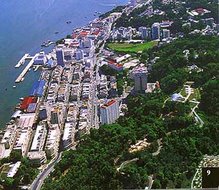 ew settlement, "Elopura" meaning "The Beautiful City" but the name reverted to "Sandakan".
ew settlement, "Elopura" meaning "The Beautiful City" but the name reverted to "Sandakan".In 1883, the British North Borneo Chartered Company moved its capital from Kudat to Sandakan. A "building mania" started and Sandakan became a bustling modern town though Allied bombings to liberate it towards the end of World War 2 nearly flattened the town.
In retaliation, the Japanese burnt whatever remained and Sandakan as a town, ceased to exist in June 1945. In 1946, the capital was moved to Jesselton (subsequently, renamed Kota Kinabalu).
Sandakan was first and foremost a port for the export of logs and timber. In fact, it was said that Sandakan timber went into the building of Peking's Temple of Heaven. In its heyday, Sandakan used to boast of having the greatest concentration of millionaires in the world! Today, it is known more as the gateway to nature's most prolific treasures in Borneo.
keningau

Keningau
Keningau is a sprawling timber and agricultural town located in Interior Division of Sabah, east Malaysia on the island of Borneo. Keningau's population was estimated to be around 88,400 in 1991, with Kadazan-Dusun forming about half the official population, and ethnic Murut making up another third; however, illegal immigrants from Indonesia and the Philippines form a major component of the actual population of Keningau.

Keningau district is a popular destination of government servants and tourists alike. This is due to its past history. Keningau was used to be one of the most important administration centers of the British in the early 1990s. Later, during the Japanese occupation, the Japanese also made use of Keningau as one of its government's centers.

Keningau is also made of a number of mukims and villages. However, it is basically divided into Keningau town, Bingkor and Apin-Apin. Keningau is the meeting place and currently the administrative center. Bingkos is well-known for its past highly-revereed leaders, who not only fought the colonial masters but also fought for independence. Apin-Apin is a mukim made of not less than 20 kampungs.
In Apin-Apin, stood one of the oldest schools in Sabah, i.e St James Primary School. One of the villages in Apin-Apin is Kg Nuntunan. Kg Nuntunan was used to be knowned as "44", which means, administrative wise, Nuntunan was about 44 miles from Tenom. Kg Nuntunan was also known as "Office", because the British had its office by the Sg Apin-Apin riverbank, which was later taken over by the Japanese. When British made a comeback after the Nagasaki and Hiroshima incidents, Kg Nuntunan was the place where the remnant Japanese soldiers surrendered. It is widely believed in Kg Nuntunan that the Japanese soldiers had hidden some treasures around the village. Whether it is true or not, nobody knows. However, there are some 90 degree terrains in Kg Nuntunan, which is inaccesible, that is believed to be the place where the Japanese soldiers hid their gold treasures or even their shotguns.
tambunan
Crocker Range National Park - Places of Interest

If you are planning to visit this route, there are many stop over places along the Kota Kinabalu-Tambunan Highway. If you are only planning to go as far as Tambunan town, the first stop will be at Gunung Alab, where there are a couple of restaurants serving a variety of oriental dishes. The two mountain restaurants do offer rooms for overnight stays, but they are usually patronised only by locals. Many travellers on their way to Tambunan or from Tambunan to Kota Kinabalu will stop over for a break and for food. The restaurants' altitude boasts a cool climate which is a great break-away from the heat for many locals. On a clear day, one has also a spectacular view of majestic sunsets, and one can see as far as Kota Kinabalu and its islands.


As you cross the Sunsuron Pass you will find on the right side of the road a small visitor's center which is on the northern boundary of the Crocker Range Forest Reserve. A number of wild orchids have been transplanted here, and can be spotted along several short, easy trails.
After refreshments, be sure to stop at the attractive and informative display centre at the Rafflesia Reserve, where you can learn about the weirdest flower imaginable: a parasitic plant which takes months to develop a flower up to almost one meter in diameter and which smells like rotten meat. You may be lucky and have only a five-minute walk to see a Rafflesia in bloom, or you may have to walk for up to 1 1/2 hours in very steep terrain. The Rafflesia Reserve is under the management of the Sabah Forestry Department. There are some well known sites at the edge of the park, only a few minutes' walk from the main highway where this huge blossoms can be seen, if you are lucky. The Rafflesia Reserve imposes no entrance fees, but you have to take a guide at RM 20.
The Rafflesia is a parasitic plant, without leaves, roots or a stem of its own. It gets its food from the forest vines (Tetrastigma) on which it grows. Buds emerge from inside the roots of the vine an take nine to 21 months to grow before the flower opens. But after only a few days, the flower fades and dies. While there is no particular flowering season for Rafflesia, most flowers are recorded in August to October as the buds, highly susceptible to rot in wet weather, have a higher chance to develop during the dry season. However, flowers can, and do, appear at any time of the year. The Rafflesia can only be found in Borneo, Indonesia, Malaysia, the Philippines and Thailand, and there are several different species.

Pass the Rafflesia Forest Reserve and you come to Kampung Sinsuron with its terraced padi fields. Depending on the season, the view can be spectacular: during the planting season, the entire fields are very, very green. Just before the village there is a stretch of stalls selling locally produced fresh vegetables and fruits. Do stop and check out the local delicacies on sale. A speciality of the Kadazandusun is 'tuhau', a relish made of pickled wild ginger stems. During season, you will also find conserved bambangan (a wild mango), and pickled fish - the curious traveller might smell at it, but be warned, the latter is for the acquired taste and quite strong!

When you reach the Tambunan Valley with its padi fields, after the junction to Ranau, turn right and look out for the Mat Salleh Memorial. It is to to your right if you are travelling to Tambunan town, about 70 km from Kota Kinabalu. The memorial is on the actual site of a fort built by Mat Salleh, sometimes also called "North Borneo's First Native Hero" (not to be confused with the Peninsular Malaysian term for Caucasians). For six years Mat Salleh led a rebellion against the Chartered Company Administration, and his first major fort was in Ranau. The North Borneo Constabulary besieged his his fort in Tambunan, and on February 1st, 1900, during a fierce battle, Mat Salleh met his death. The Sabah State Government erected a stone memorial in Tambunan town to commemorate Mat Salleh and recognises him him as one of Sabah's earliest freedom fighters. The Memorial also exhibits some photographs and some of his weapons and items related to the tragic battle.

There are other attractions in Tambunan, such as the Musical Stones at Kampung Solibog. The Tambunan Village Resort Centre (TVRC) is just before you arrive in Tambunan. It is a great place to relax or stay overnight. A particular place of interest within TVRC is the Kilang Tapai, or rice wine factory. Learn how this best known of all indigenous drinks is brewed! You can proceed your journey back to Kota Kinabalu or you can drive further south to the largest town in the interior of Sabah, Keningau. Once, Keningau was were most of the timber industries were located. However, due to environment and conservation policies of the Government towards sustainable forest management, the timber industry has greatly slowed down. If you have time, do visit Keningau and Tenom with its major attractions such as the Murut Cultural Centre and the newly upgraded Sabah Agricultural Park.
ranau
poring ranau:

Located 39 kilometers northward is the Park's station at Poring Hot Springs. Chartering is virtually the only way to get there. You can soak yourself in the skin-curative properties of a hot sulphur bath, take the various trails leading through rich lowland forest, mountain streams and waterfalls towards the bat caves. Do some bird watching along the way through your binoculars. There is also a playing field and volleyball court if you are game-inclined.
At the Poring Hot Springs, if you are lucky you may see a Rafflesia, the world's largest flower, in bloom. You can also visit the Orchid garden that contains a wide selection of the local species, some of which are endemic to the area and very rare. Butterflies and moths are also seen around the area. Make your way gingerly along the swaying tree top canopy walkway. You will be rewarded with new insights of the tropical forest and eye-to-eye view of its tree top denizens. Look down, and you will probably see and iridescent cloud, a host of butterflies hovering below you, their fluttering burnished many-coloured wings reflecting the sunlight filtering through the verdant forest leaves.
perkasa hotel mt.kinabalu:
 The hotel is situated a top a hill approximately 5,000 feet above sea level and has a commanding view of the majestic Mt. Kinabalu, the highest mountain in South East Asia, and also a panoramic view of the sprawling foot hills dotted by temperate vegetable farms of Kundasang and the natural cool atmosphere. A major resort area with the Kinabalu parks, the Poring Hot Spring, a beautiful Golf Course, Flora & Fauna, and other places of interest which are easily accessible from the hotel.
The hotel is situated a top a hill approximately 5,000 feet above sea level and has a commanding view of the majestic Mt. Kinabalu, the highest mountain in South East Asia, and also a panoramic view of the sprawling foot hills dotted by temperate vegetable farms of Kundasang and the natural cool atmosphere. A major resort area with the Kinabalu parks, the Poring Hot Spring, a beautiful Golf Course, Flora & Fauna, and other places of interest which are easily accessible from the hotel.
For the adventurous types, the hotel offers a special package for climbing Mt. Kinabalu. Perkasa Hotel Mt. Kinabalu - an ideal place to come to whether for holiday or relaxation, seminar or adventure!
the kinabalu park:

Covering 754 squares kilometers, the Kinabalu Park is one of the greatest attractions of Sabah. Within its boundaries are found the lowland rain-forest of the tropical zone as its lower level, the mountain oaks and fig trees, the rhododendron shrubs and wild berries of the temperate zone at its medium level, and the conifers and other alpine-like associations of the summit zone at its upper level. It is there no wonder that a good number of its visitors are nature lovers eager to study, record and enjoy its richly varied natural resources.
The Park also has this "away-from-it-all" cool serenity that offers a much needed rest for the tired businessman. It offers the highest mountain in South East Asia to challenge the ambitious mountaineer, and ever-changing grandeur- the magic of sunrise as the stark majesty of the mountain appears before you in the brightening sky, only to be quickly hidden behind a cloudy shroud billowing upward from the lowland forest, or the sky awashed in the wondrous colours of sunset that prompts the avid camera buff to wait patiently for the right moment to click his masterpiece.
RAFFLEASIA:
One of world's largest flower grows along the mountain path of Mount Kinabalu.
Only one million and half years ago, a mass of granitic rock that had been cooling and hardening under the surface for several million years began to rise and break through the overlying crusts of softer rocks. Erosion by heavy rains and, later, by ice and glaciers shaped the new mountain. Even today the striations, "glacial polish" and the sculptured and streamlined forms and the summit peaks give witness of the effects of this glaciation. Millions of tons of rock debris were washed into lowland approaches of the mountain.
The Park Headquarters itself sits on a ridge of accumulated muds, clay and rock washed off the eroding heights 34,000 years ago. With the return of a warm climate and the melting of the glaciers, Kinabalu attained its modern form and appearance. At its present height of 4,101 meters (13,455 feet) Mount Kinabalu is still rising at approximately 5mm per year. The landslides on its slopes and rocks debris beneath its peaks are evidence of its still-continuing movement Nature's powerful forces have produces a scenic location of remarkable beauty. The gradual evolutionary process has also resulted in fauna and flora, some of which are found nowhere else in the world.
The slopes of Kinabalu are the home of the hill tribes of Dusuns or Kadazans who believe the mountain to be the resting place of the spirits of their departed and therefore remains sacred to them. Their Kampung or villages are scattered throughout the area and they traditionally plant rice and other crops on the steep slopes on a shifting cultivation basis. They scamper up and down the mountain with the greatest of ease, often with heavy loads on their back. They are the registered mountain guides you are required to hire for the climb.
MESILAU NATURE RESORT:
Imagine being surrounded by 600 million years old of rainforest and pampered by attentive staff and luxurious accommodation. The feeling can be described as just 'awesome'. Mesilau is a brand new nature destination at its best.
Located in the Kinabalu area, Mesilau stands in between the Kinabalu Park and the Poring Hot Springs. Its elevation is at approximately 2,000 metres above sea level. One will feel a strong sense of nature as Mesilau is on the Pinousuk Plateau which is richly endowed with flora and fauna. The cool climatic condition in the highlands combines with the mist and evergreen environment creates an exotic and mysterious atmosphere.




















